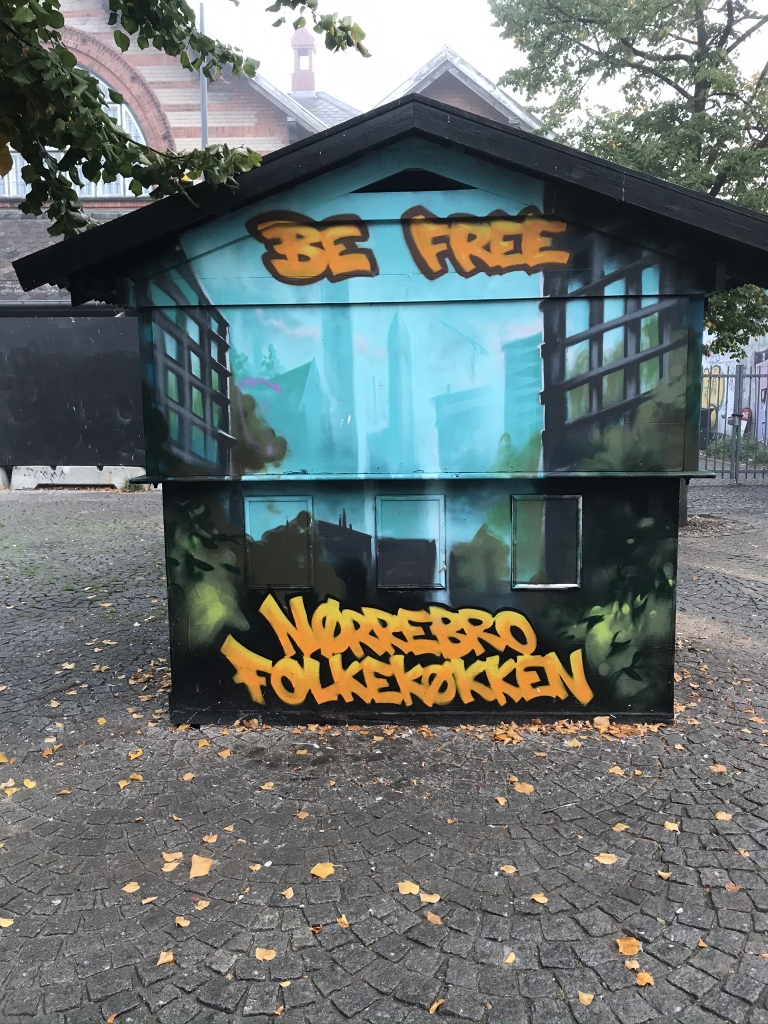When we last left off, I had just boarded a train in Odense, Denmark, departing for Copenhagen at 12:57, after spending the morning in a railway museum.
Tuesday, September 22, 2020
The train from Odense to Copenhagen lasted a little under two hours and I blew away most of this time playing a web-based game on my tablet, a game I had gotten dangerously addicted to during this trip. The name of this game is 2048. I think it's so addictive because it's both extremely simple and extremely tough to beat. I whiled away so many hours during this week, mostly on train rides like this, playing 2048 and never could beat it. It wasn't until I was at home a week or two after this trip that I finally won the game and, thankfully, after that my desire to play just one more time went away.
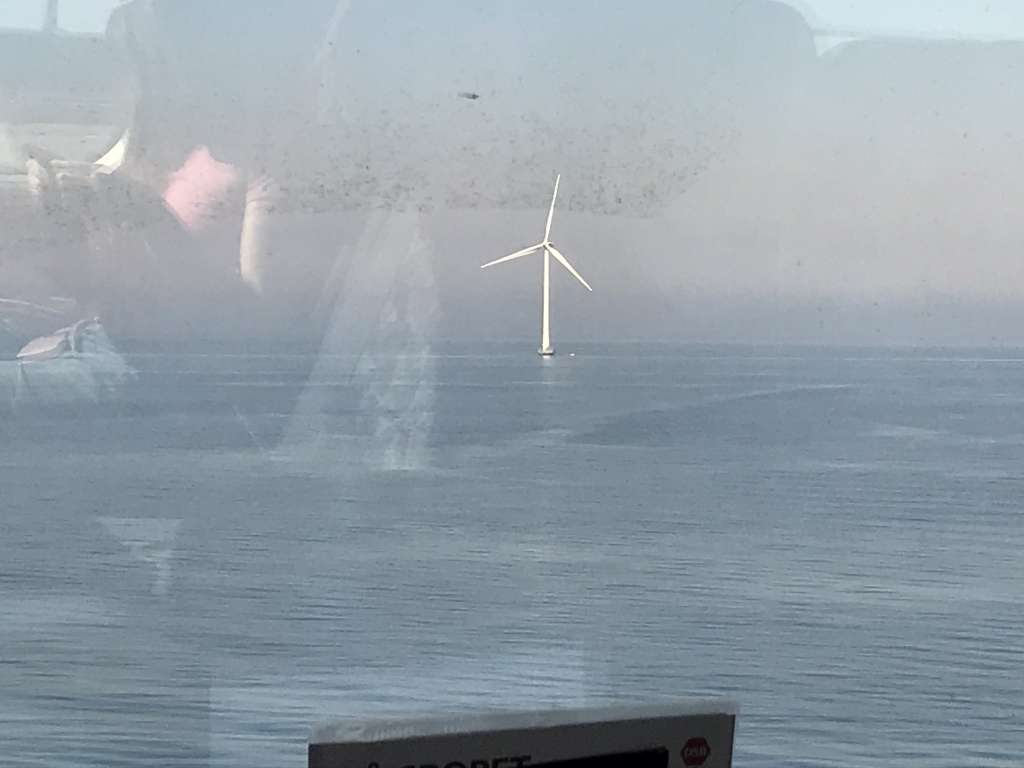
Wind turbines in the Great Belt, the strait dividing the islands of Funen, where Odense is, and Sealand, where Copenhagen is.
I stepped off the train in Copenhagen's central station. After walking around the station for a bit and familiarizing myself with the local transit system, I bought myself a 48-hour ticket and figured out how to get myself to my hostel which was in the Norrebrø neighborhood. Much like in Hamburg and Berlin, Copenhagen's transit system has two train networks: a subway called "Metro" and a commuter rail called "S-tog" (analogous to German cities' S-Bahn). To get to Norrebrø I would have to take one of four S-tog lines that were going north, step out at Hellerup, and then ride the F line south from there.

I had to take a picture of the inside of the S-tog because I really liked how retrofuturistic it looked. I don't know when this was built or designed, but it looks like something out of a '70s sci-fi movie. I mean, this is exactly what people circa 1975 thought 2020 would look like.
Here is where I must mention Danish quirk #3: those glass doors that separate compartments in the train cars, which open automatically in most countries, you have to wave your hand in front of them to open them.
The hostel where I would be staying two nights in Copenhagen was called Urban Camper. This place seemed interesting when I found it on hostelworld.com. What's unique about it is just the way it's designed; instead of dorm rooms there are large tents with four beds, all lined up in a huge open room.
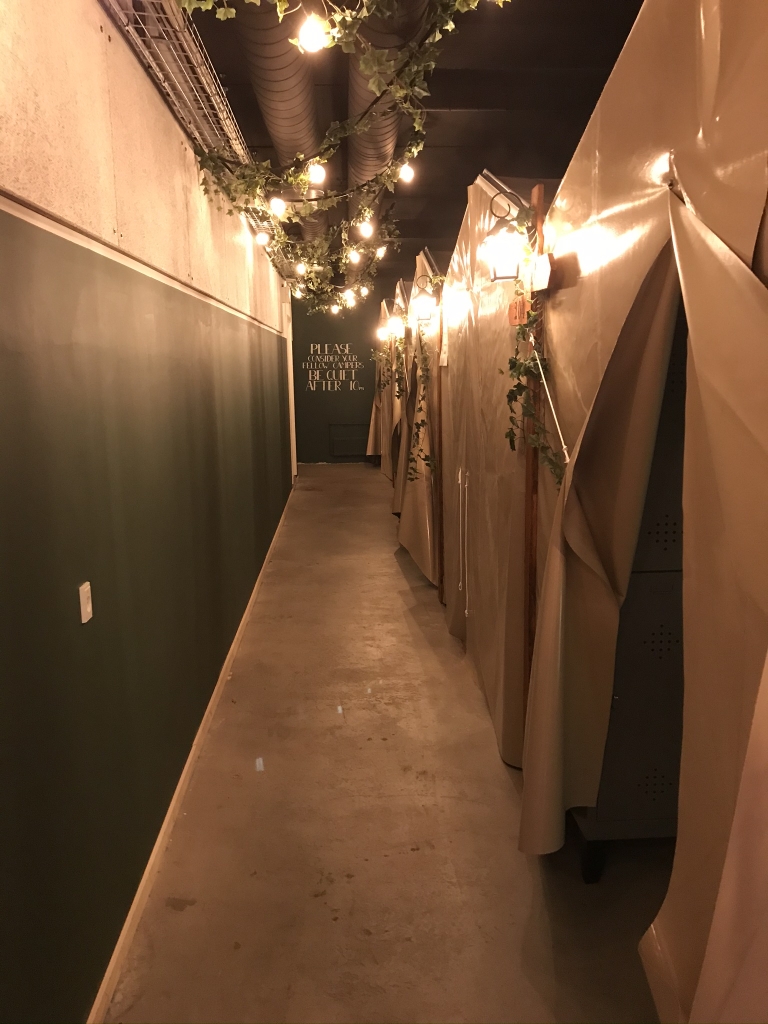
I think there were two floors like this. Each of these tents has four beds, stacked up in two-bed bunks. On the other side of the left wall is where the bathrooms are (the door is around the corner).
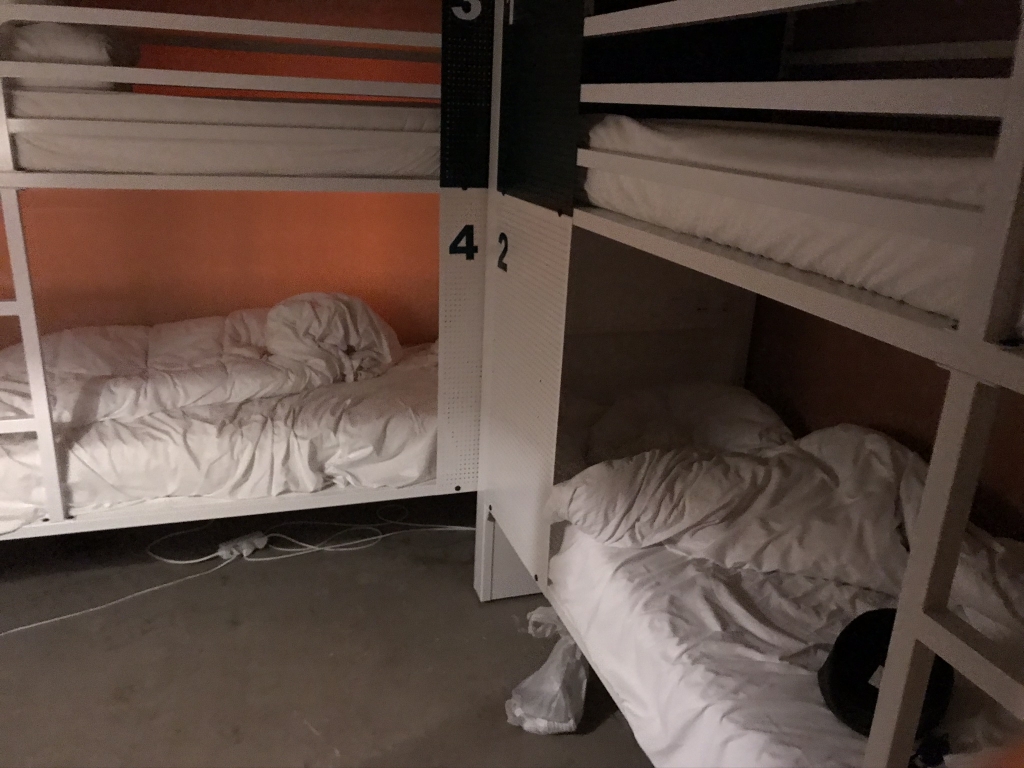
What it looks like inside a tent. It was hard to get a good picture because it was rather close quarters. You can’t lock the tent flaps but you do need a keycard to enter the floor where all these tents are. Also there are lockers here which couldn’t fit in the picture, but you need to bring your own lock, which I did.
So really, it's little different from any other hostel, once the novelty of the tents wears off. As far as hostels go, I thought it was pretty good and I'd stay there again if I found myself back in Copenhagen.
The reception area, like many of the better hostels out there, had a bar. And afternoon was their happy hour, so I had glasses of Odense Pilsner and Odense Classic.
The first place in the city I had to check out was a neighborhood I'd heard about, Christiania. It's southeast of the city center and to get there you must take the M1 or M2 Metro lines to the Christianshavn station. I'd heard Christiania described as a "hippie commune," and while that's not quite accurate, it does come close. This pedestrian-only neighborhood is a huge collection of independent, mom-and-pop shops, kiosks, bars, restaurants, cafés, and such, all in a very arty-looking area which apparently has some kind of unspoken agreement with the police under which they never enter the place. Because of that last bit about the police staying out of it, I kind of expected it to be like '80s Times Square, with all the crime and seediness that implies, but it wasn't like that at all. When I saw families with young children there I realized that Christiania was perfectly safe.
There is no shortage of places to eat in Christiania, mostly clusters of food trucks with a lot of picnic tables. I stopped at one such food truck called Mr. Shawarma and had a delicious chicken shawarma wrap.
There are also plenty of places to get a drink there. In fact, there's even a brand of beer named after the neighborhood.
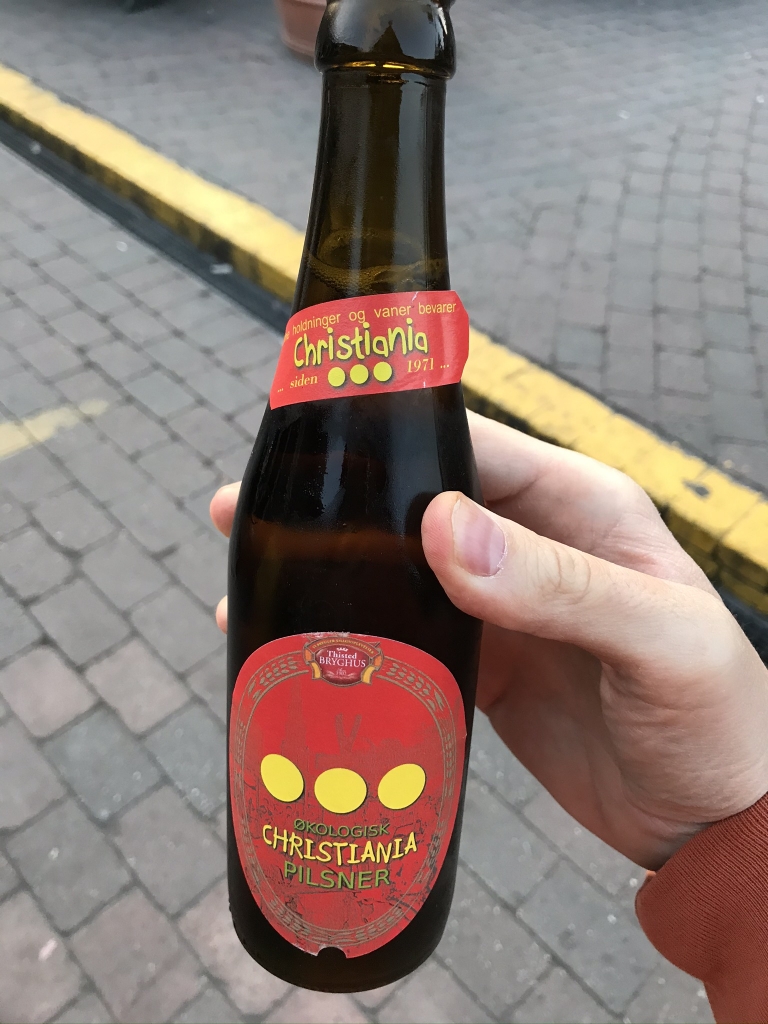
Christiania Pilsner. It was OK. I wonder if it's actually brewed there?
I also found one kiosk selling vinyl records. I spent a lot of time flipping through the selection and bought a pair of classics, Kraftwerk Computerwelt and Joy Division Warsaw. Unfortunately I haven't been able to listen to them since then, since my turntable is only 120 volt, so I'll have to wait till I move back to the States.
As the sun was going down, I stopped by one more café-bar and had an Irish coffee, which I was pleasantly surprised to find there.
That was all I did in Christiania, but I suppose I shouldn't leave the place behind without mentioning one more famous part of it: Pusher Street. I think this is the main reason for the gentleman's agreement with the police. Along this one drag are rows of people selling hashish bricks! You can buy and consume all the hash you want in Christiania with zero legal consequences. I didn't partake, but if you do plan on it, be advised that I also read (I didn't actually witness this) that while the police don't enter the neighborhood, they do regularly shake down people at the Christianshavn Metro station.
Wednesday, September 23, 2020
Breakfast at Urban Camper was kind of sparse compared to a&o and Danhostel, but it still gets a thumbs-up from me. All they had to eat was rolls, butter, and deli meats, but that was just fine. The rolls were fresh and hot, and tasted great with the butter. I had one buttered roll and made the next into a sandwich with ham and salami.
There was no coffee, though, so I had to get my first coffee down the street at a 7-11. And that reminds me of Danish quirk #4: there are 7-11s everywhere. I could not believe how many 7-11s there were everywhere I looked. Nearly every street corner has one, if not two. Most train stations have at least two. So I had my first coffee of the morning at a 7-11 and it wasn't half bad. As we already learned in Odense, Danes love coffee more than anyone else in the world, so I suppose they would expect high quality even from corner stores.
It was also during this morning I started to notice Danish quirk #5: they really love bikes. There are so many people riding bikes around Copenhagen, I don’t think I even saw this many in Amsterdam, and that’s saying something. Needless to say, every street has a bike lane. I wish I could live in such a place.
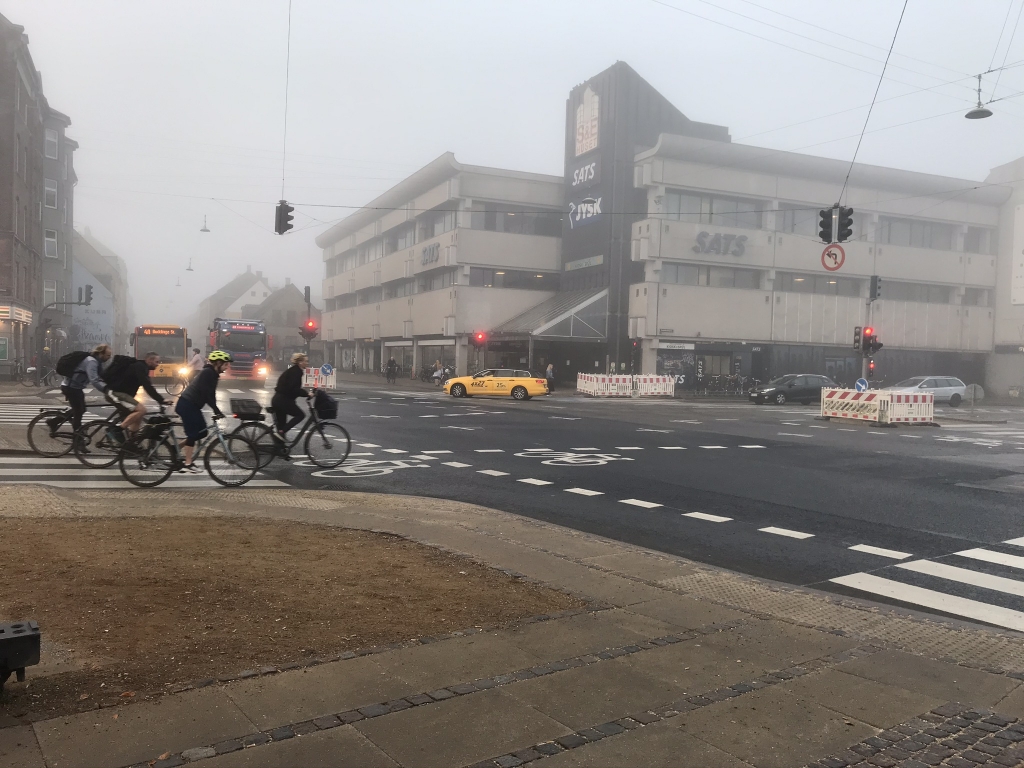
To the left you can see people who are probably on their morning commute. They were only at the front of a much larger swarm.
Next I had to do some grocery shopping, both for provisions I needed right then and for things to take home, so I stopped in a store called Føtex. Among other things I got a six-pack (cans) of Tuborg Classic beer and a bag of müsli as usual. But I also found something I did not expect to be buying there. As I just mentioned, Danes love bikes, so unsurprisingly there was a whole aisle full of bike supplies right there in the grocery store. My local Kaufland in Germany has a bike aisle, but it isn't nearly this extensive. I found a great headlight/rear light set which can fit any width of handlebar, which is great because until then I hadn't been able to find one that fit mine.
I also needed to stop in that store just so I could get a grocery bag with its logo on it, because living in Germany, where reusable bags are required, has turned me into an environmentalist, and I want to move back to the States with as many bags from as many different stores as I can. If at some point in the future you see someone in the Rocky Mountains or southwest US walking out of a supermarket carrying groceries in a Føtex bag, it'll probably be me.
After dropping off my groceries at my tent in the hostel, I got another coffee in the central train station while deciding how to spend the day. In almost every city I have visited over here, I have seen "Hop On Hop Off" tour buses circulating. I had always forgone them, preferring to make my own path and plans, but this time around I decided to buy a ticket for this one.
The Hop On Hop Off buses work like this. Along the route there are going to be several--I don't know how many but there must be at least two--Hop On Hop Off buses working their way along a circuit through the city, hitting all the well-known hotspots. As the name suggests, if you have a ticket you can hop on any of the buses when you see them, hop off when you reach a place you like, hop back on at your leisure to keep moving, and so on. There is also recorded audio narration in various languages, which you can listen to at your seat with provided earbuds.
I hopped on right outside the central train station, and rode along as it proceeded north, and I listened to the informative narration as it told me the bus was passing by sights such as the royal palace. What I was looking for at that moment was the famous "Little Mermaid" statue, so I hopped off when the bus reached its closest point.
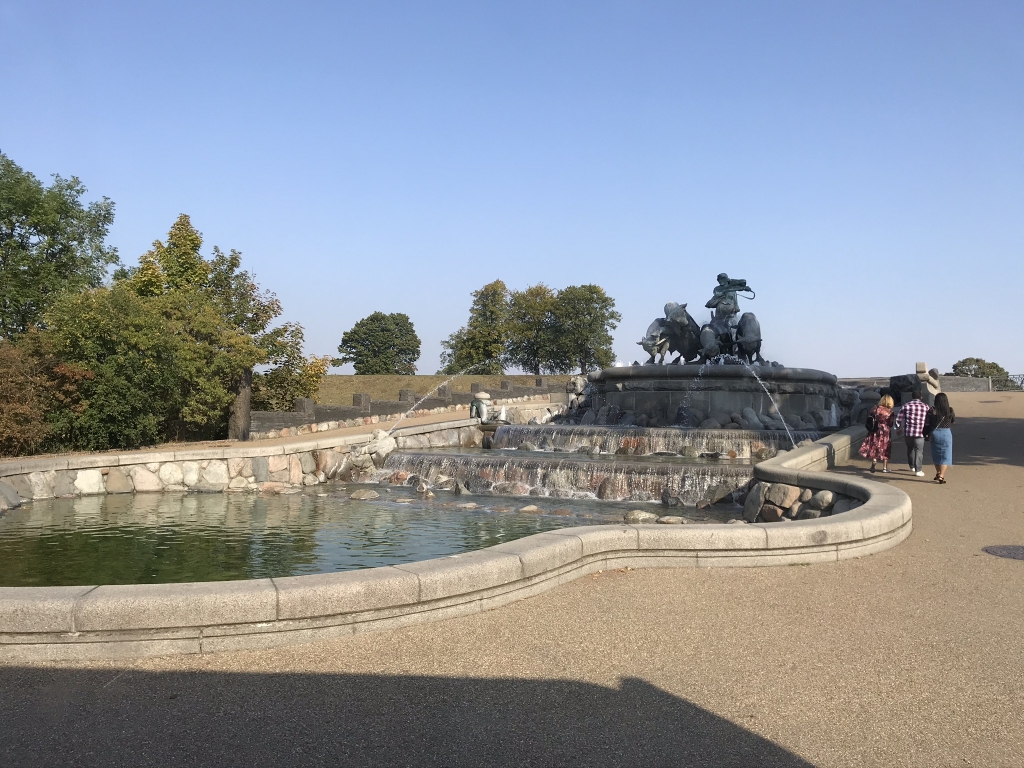
The first thing I saw after exiting the bus was this statue fountain. The narration on the bus explained that the statue represents a scene from Norse mythology: Gefjun and her four sons she turned into oxen. Why did she do that? Swedish king Gylfi promised her all the land she could plow in a night. They dug up a huge land mass they flung into the sea, which became the isle of Sealand, which Copenhagen is built on.
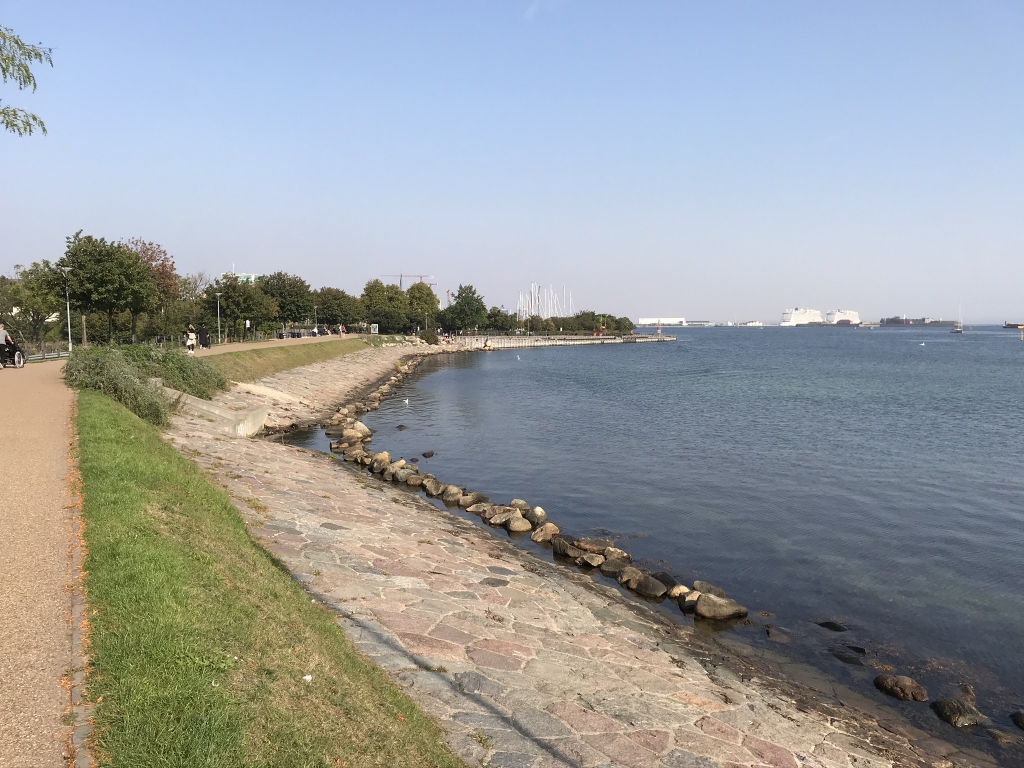
The shoreline I walked along from the Gefjun statue fountain toward the Little Mermaid. You can see a couple huge cruise ships off in the distance.
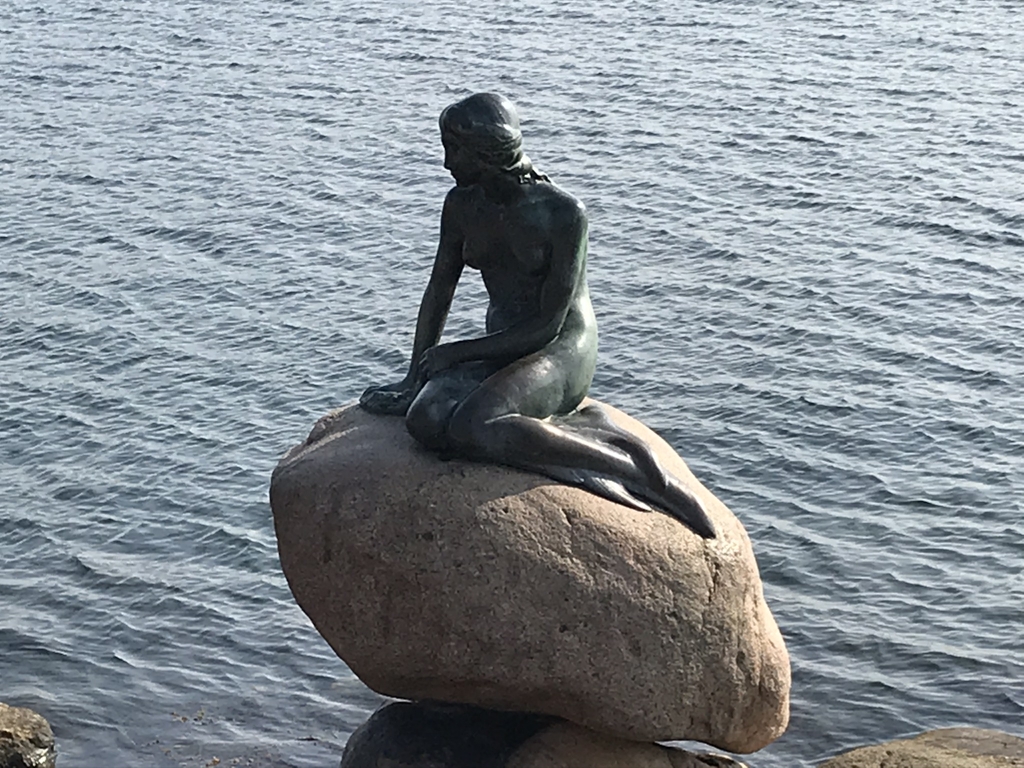
So here's the famous Little Mermaid statue, sculpted by Edvard Eriksen in 1913. Eriksen was commissioned by Carl Jacobsen, founder of Carlsberg Brewery, to make this after Jacobsen saw a ballet performance based on Hans Christian Andersen's fairy tale and felt totally captivated by it. Odds are you only know the story of the Little Mermaid from the Disney film. If you know anything about the liberties Disney takes with the fairy tales they adapt into films, it should come as no surprise that Andersen's original story doesn't have the happy ending we all know, with the mermaid living happily ever after with the prince, but instead has her becoming a wind spirit.
From there I walked back toward the center of the city. I just happened to pass by the palace, and when I saw a small crowd gathered there I remembered something I'd heard in the bus's narration and realized I had just missed the changing of the guard.
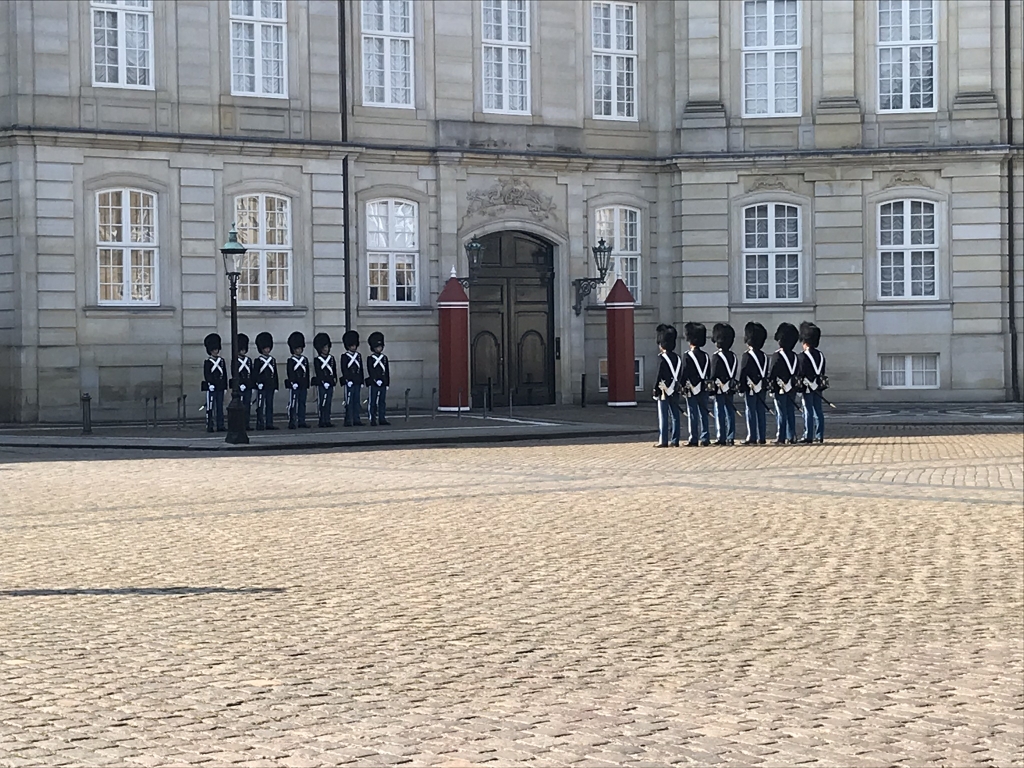
But there were still guards in their ceremonial uniforms lined up so I didn't entirely miss the spectacle.
I had lunch at a restaurant called The Modern, a salad with walnuts, beets, grapefruit, and fried goat cheese. On the menu, the fried goat cheese was called "Chèvre," which I knew means "goat" in French; apparently the Danish have borrowed that word to specifically refer to goat cheese.
Speaking of cheese, I bought some in a shop I found while walking after lunch. This is one thing I love about Europe generally, you can buy so many varieties of cheese in blocks. The one I bought here, I don't remember the name of, but the man behind the counter said it was similar to Dutch gouda cheese. I also thought so after tasting it. I don't know how I'll ever adjust to Sargento slices after I move back to the States.
It was still a long way back to downtown so I caught another Hop On Hop Off bus, and hopped off near another place I wanted to check out, the Planetarium. Unfortunately I found it was indefinitely closed due to the pandemic.
The Hop On Hop Off ticket I bought also included a boat tour. I made my way over to the docks to catch one of those. The tour lasted about an hour and I thought it was worthwhile. Copenhagen, much like Amsterdam, is a low-lying city full of canals, which this boat wound its way through.
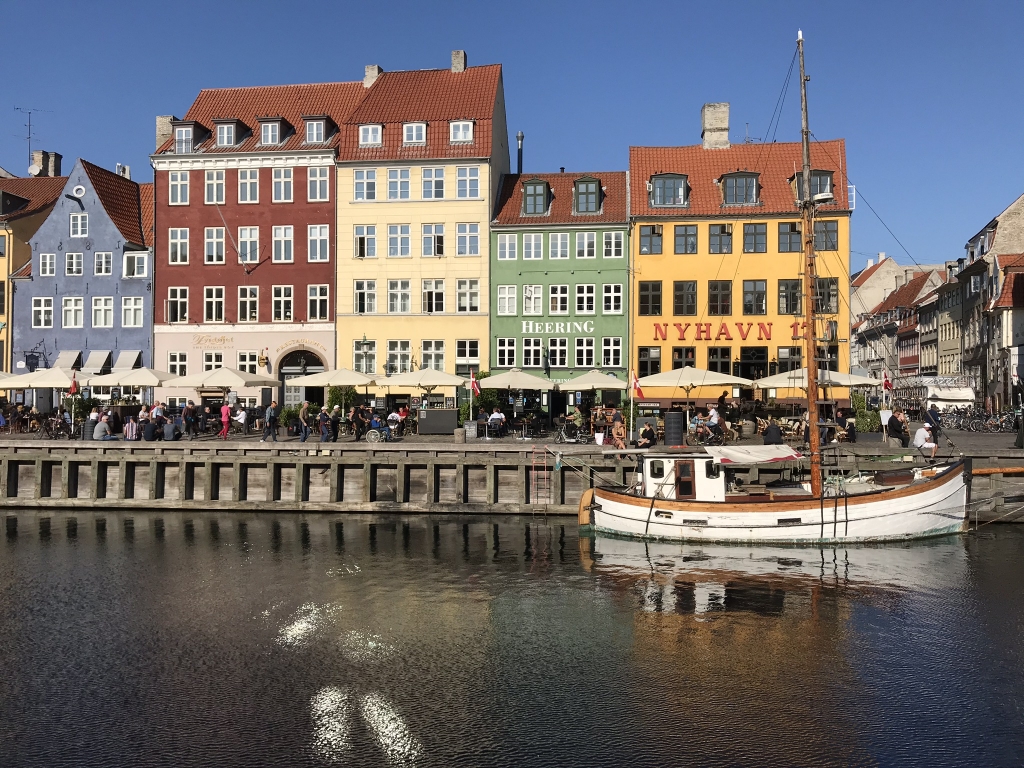
Dock area where the boat tour started and ended. After the tour I'd be back here to hit up some of those bars and restaurants.
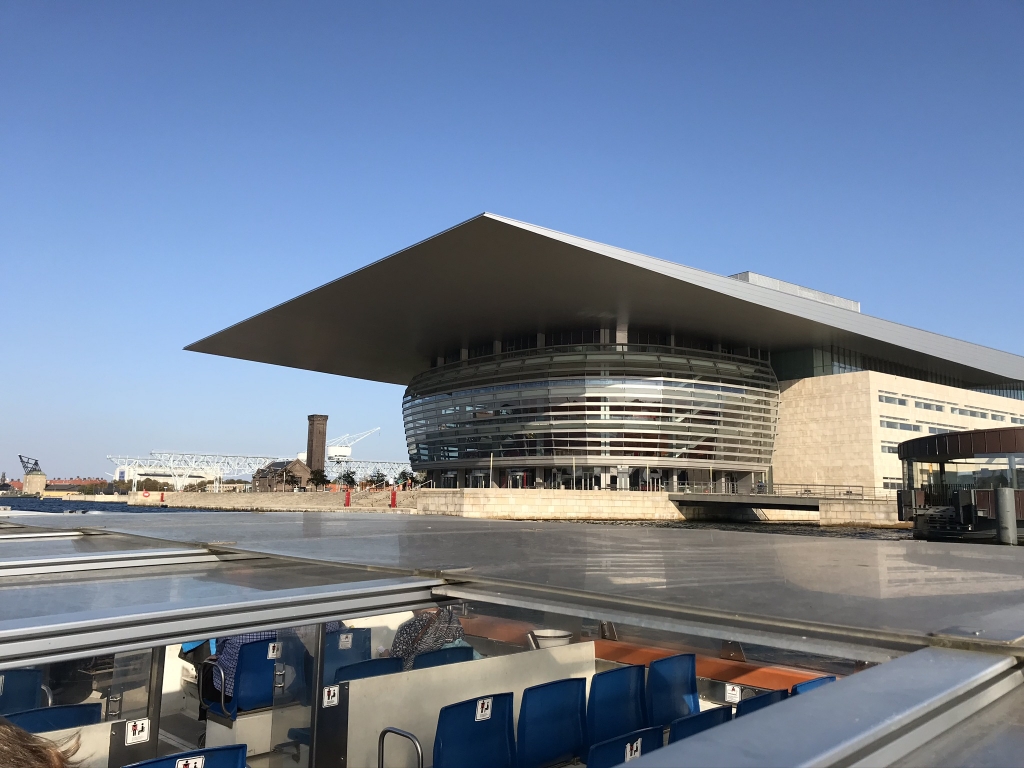
Royal Opera House seen from the boat.

Church of Our Saviour (Vor Frelsers Kirke), a landmark near Christiania.
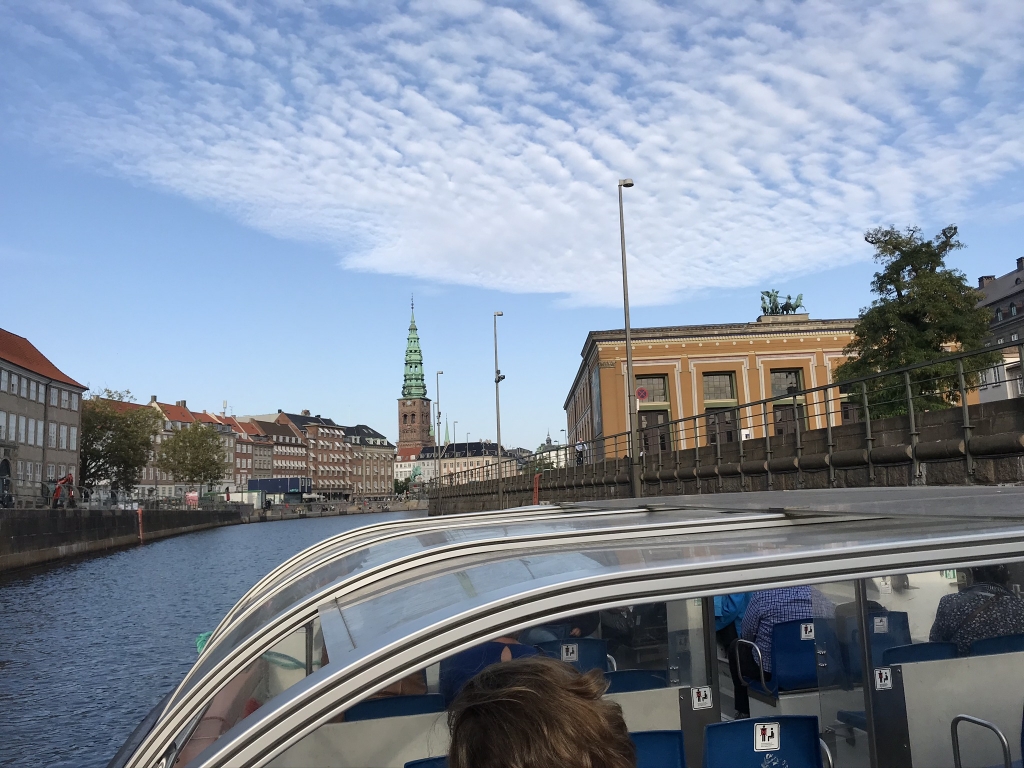
Thorvaldsens Museum on the right, while up ahead is Nikolaj Kunsthal, a modern art museum in a former church.
With the boat tour over, I now found myself back at the docks lined with restaurants and bars, and it was getting to be about time for dinner. First stop was called Tipsy Mermaid where I had a 50cl of a beer called Ale No 16, and a coffee. Second stop, for dinner, was a restaurant called Heering. This may have only been coincidence, but at Heering I had a dish made with three types of...herring. I also had something else wonderful at Heering:
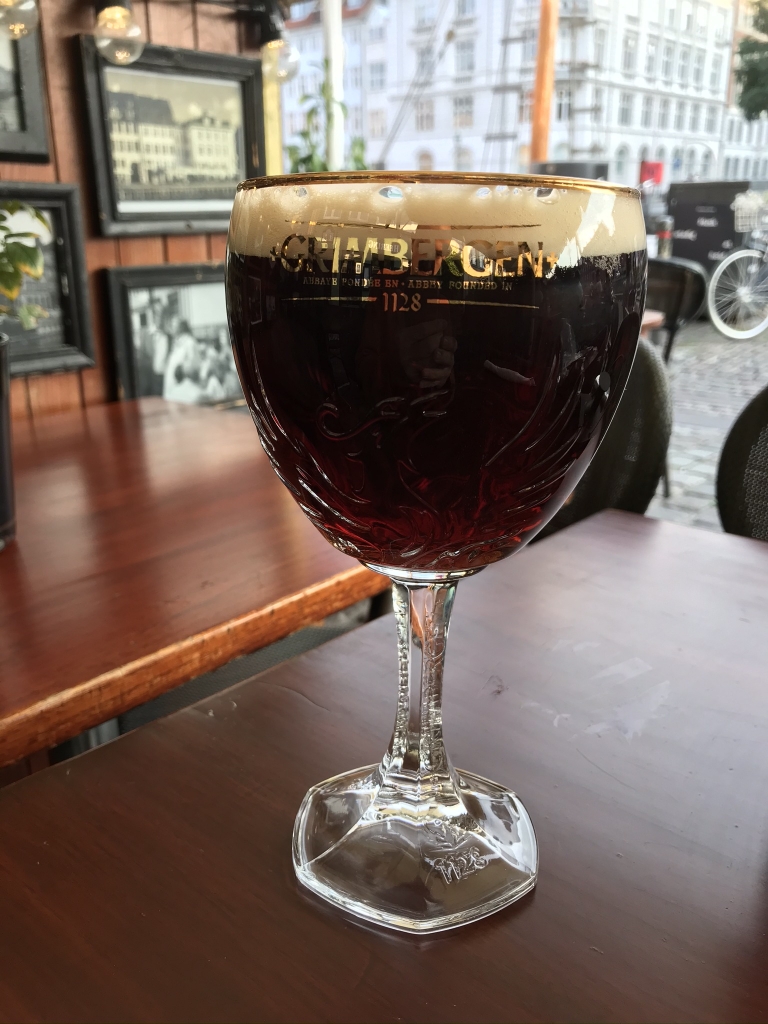
50cl of Grimbergen, a tasty, strong Belgian ale. I found that many places in Denmark served Belgian beers, probably because Belgium is pretty close by.
My last stop was called Fisken Pub where I had an Irish Coffee. What I found most memorable here was how they put the sugar in it. It was brown sugar, as is usual for an Irish Coffee, but it was in the form of a clump of unusually large crystals stuck to a little stick dipped in the drink.
That should've been the end of the drinking adventures that day, but when I got back to the hostel and they had the open bar in the reception area I saw they had Affligem, yet another great Belgian ale. So I had a 30cl glass of that...and more. The Urban Camper's reception bar is quite well-stocked and they do have an impressive array of bottled and canned craft beers. So I had to have one of those, Stay Puft Marshmallow Porter. Not bad, but not good enough that I'd want more. So to finish this night off on a high note I had a pint--yes, a whole pint--of Odense Classic.
Around here I wisely decided to avoid alcohol the next day. As it turns out, Sweden, where I would be going the next morning, was an unusually easy country to avoid alcohol in.
Other articles in this series:
- A Weekend in the Ruhr
- A Night in Odense and a Railway Museum
- Two Days in Copenhagen
- Passing through Gothenburg
- Ending the Trip in Kiel and Hamburg
